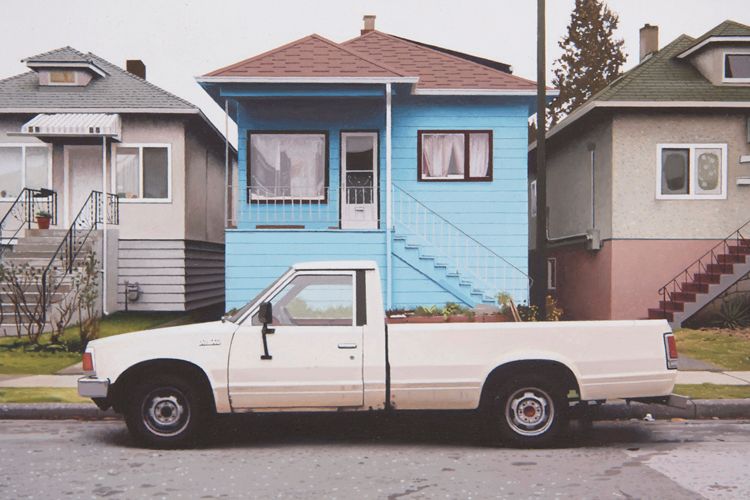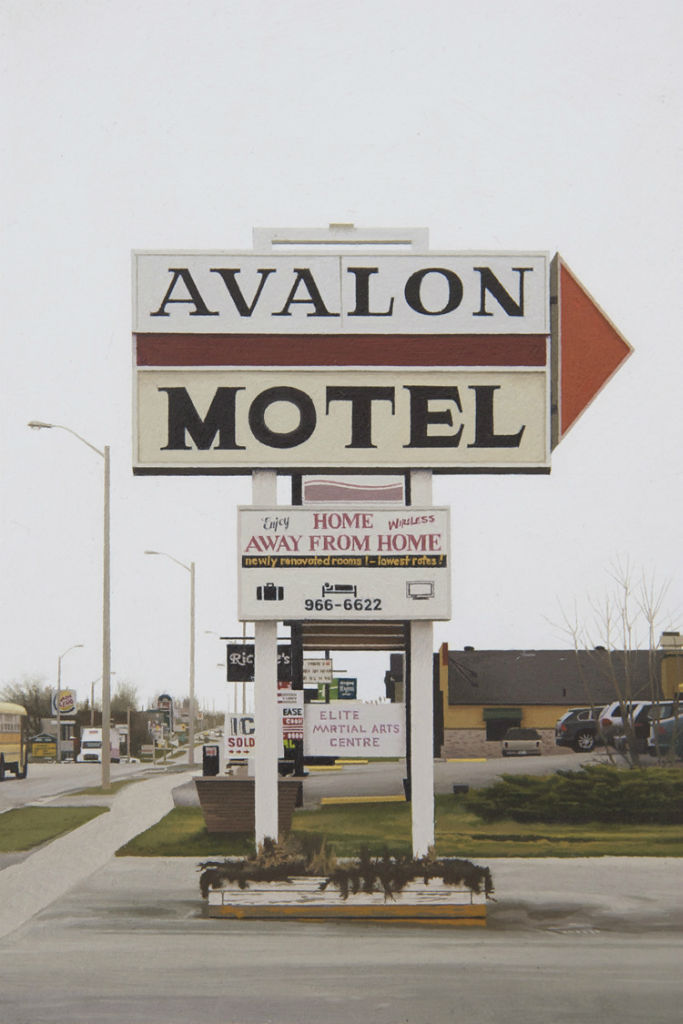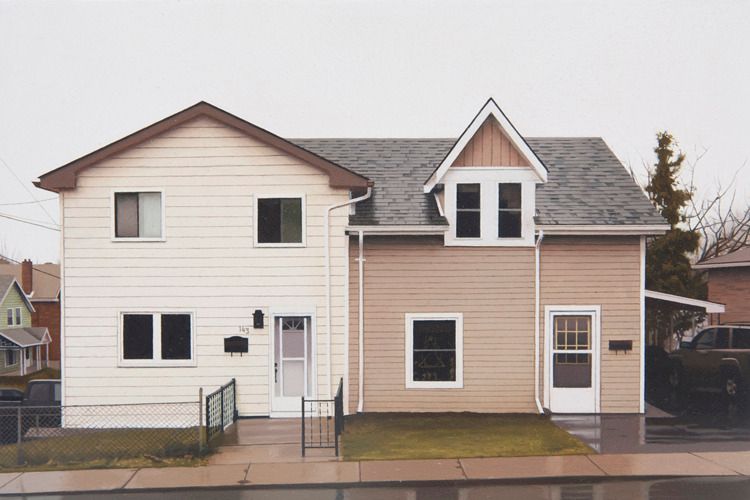„It’s as if they represent the moving away from idealism and more towards something like a collective shrug.“ INTERVIEW with Mike Bayne
Views from North American suburbia. In the same format – your average drugstore-sell-printing-photo size -, in a perspective from the front, as seen from a car rolling past. Wooden houses, big cars parked in front, signs and advertisements. An atmosphere of the provisional, the provincial. Deserted, but still inhabited.
These snapshots, as casual and incidental as they might appear, are not photographed, but – painted. The amazing works of Canadian artist Mike Bayne present meticulously painted views in photo-realistic style. In the choice of his motives, Bayne – holding philosophy and fine art degrees at Queen’s University (Kingston, Ontario) as well as a Masters of Fine Art at Concordia University (Montreal) – seems like a documentarist of his surroundings in Ontario – unadorned views, prosaic sceneries, the economic crisis shows through everywhere. At the same time the artist proceeds in very personal way, he does not seek these motives, but finds them. Also, he deliberately chooses the small format typical of self-made photographs, in which they have become ordinary objects of everyday use. However, Bayne transfers these found snapshot-like motives into carefully handcrafted, elaborate paintings. The volatile, replaceable, ordinary turns into a unique, singular artwork. A contradiction?
deocnarch.com asked Mike Bayne about his interest in suburbia, his working process and the challenges in painting the ordinary – instead of photographing it.
all illus. (c) Mike Bayne,
www.mikebayne.com
INTERVIEW
Your paintings portrait “suburbia“. Why not painting spectacular buildings, highrises, stylish modernist glass-and-steel architecture, but everyday buildings, used architecture, small, rugged houses?
My interest in suburbia and the specific types of architecture I depict in my paintings stems from an appreciation for the humility and lack of ambition of North American residential construction. The materials are cheap, the buildings have a temporary feel, and there’s a utilitarian minimalism, amongst other things. It’s as if they represent the moving away from idealism and more towards something like a collective shrug. Also, I think they tell us something about ourselves, about the way we want to recreate the world in order to appeal to human consciousness – to impose some sense of order on what looks like chaos to the human brain. And I try not to judge the results of that project – it’s not the best we can do – but, where I live, we seem to be ok with that.
Where do you find your motives?
Where I live.
And what makes you choose a particular scenery?
The approach I take to producing art work is to avoid going into a project with a preconceived idea of what the work should look like. Though I maintain the same format from work to work, a sort of realist style based on my photographs, I like the subjects to come to me spontaneously. That is to say, I don’t like to go looking for subjects but rather try to be open to stumbling across them as I go about my daily routine. Rather than try and locate ten underwhelming post second world war suburban bungalows worthy of painting, for example, I try to be open to the idea that everything is worthy of painting and to be guided ultimately by my instincts for what is appealing aesthetically. So, there’s an element of chance that I’m interested in I guess.
The paintings depict buildings and structures without inhabitants, they appear deserted. Why?
Usually, the buildings aren’t abandoned, there’s usually some sort of human presence or, in other words, some indication of human habitation – a car parked in the driveway, lawns that are neatly mowed, driveways that are shovelled, and that sort of thing. I think the feeling of things being deserted comes, partly anyway, from the reality of where I live. In small town Canada the climate is harsh and the economy is not thriving. Many of the industries that have driven these places have disappeared and people are left to looking for bargains in the big box stores and shilling their towns as getaways for urbanites.
How is your working process? Are you using photographs as an inspiration?
I paint methodically, five days a week, eight hours a day. All my work is based on photographs I have shot. Rather than take inspiration from them, though, I try and copy them exactly. As for my motives, your guess is as good as mine. I don’t like to speculate as to why we do the things we do.
You are painting photo-realistic, the size of you work corresponds with a typical photograph, too – why not photographing the sceneries? What is the advantage of painting them?
It raises interesting questions, like: What does it mean when the product of labour-intensive craft has the look of a mass produced object? I don’t have the answer for this, but recognize that it challenges the idea that the art object should be something extraordinary. The ordinary can be just as much a revelation.
Would you like to introduce a particular series?
Not particularly. I’d like to continue the project I’ve started.
Are there role models, influences, which inspire your work?
I continue to explore the entire history of paintings based on photographs, from sixteenth century Holland to the current manifestations occurring all over the world.
And finally, probably the most difficult question: Why art? What possibilities does it offer you?
I wasn’t good at anything else in school. I played a lot of sports and created a lot of art work. Everything else I did reluctantly and badly. Painting gives me a purpose.
Mike, thank you for sharing your work!












